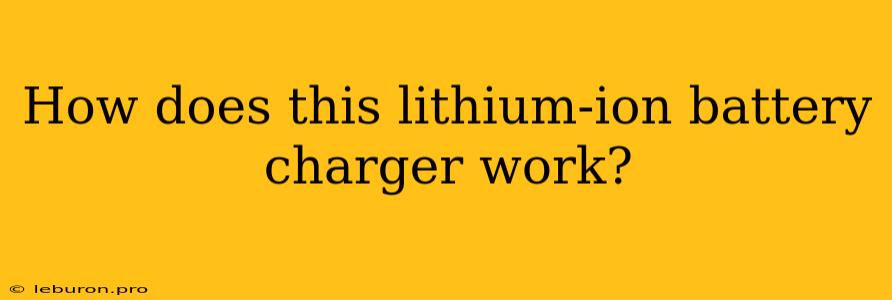Lithium-ion batteries have become ubiquitous in our modern world, powering everything from smartphones and laptops to electric vehicles and grid-scale energy storage. To ensure these batteries function optimally and maintain their lifespan, a proper charging system is crucial. Understanding how lithium-ion battery chargers work is essential for maximizing battery performance and safety. This article delves into the intricacies of lithium-ion battery chargers, exploring their components, charging principles, and safety features.
Understanding Lithium-Ion Battery Charging
Lithium-ion batteries, unlike conventional lead-acid batteries, do not rely on a simple constant current charging process. Instead, they require a sophisticated charging system that carefully manages the flow of current and voltage to ensure optimal battery performance and longevity.
The Charging Process
The charging process of a lithium-ion battery involves three distinct phases:
- Constant Current (CC) Phase: During this initial phase, the charger delivers a constant current to the battery, gradually increasing its voltage. The charging current is typically set to a specific value, determined by the battery's capacity and the charger's design.
- Constant Voltage (CV) Phase: Once the battery reaches a certain voltage level, the charger transitions to the constant voltage phase. The voltage remains constant, while the charging current gradually decreases as the battery continues to charge. This phase aims to maintain the battery at a high charge level while preventing overcharging.
- Trickle Charge Phase: In some chargers, a trickle charge phase follows the CV phase. This phase provides a very small current to the battery to compensate for self-discharge and maintain the charge level.
Key Components of a Lithium-Ion Battery Charger
A lithium-ion battery charger typically comprises the following components:
- Power Supply: The power supply converts the AC input voltage to a DC voltage suitable for charging the battery.
- Voltage Regulator: The voltage regulator ensures a stable and accurate output voltage to the battery, preventing voltage fluctuations that could damage the battery.
- Current Regulator: The current regulator controls the charging current during the constant current phase. It ensures that the charging current remains within a safe limit for the battery.
- Battery Management System (BMS): The BMS is an essential component that monitors the battery's voltage, current, and temperature. It plays a critical role in protecting the battery from overcharging, over-discharging, and overheating. The BMS may also communicate with the charger, providing real-time information about the battery's state of charge (SOC) and health.
- Monitoring and Protection Circuitry: Additional circuitry is included to monitor the charging process and protect the battery from various hazards, such as over-current, short-circuits, and reverse polarity.
Charging Profiles and Algorithms
Lithium-ion battery chargers employ different charging profiles and algorithms to optimize charging performance and extend battery lifespan. Some common charging profiles include:
- Fast Charging: Fast charging profiles utilize high charging currents to quickly charge the battery. However, fast charging can generate more heat and stress on the battery, potentially reducing its lifespan.
- Slow Charging: Slow charging profiles use lower charging currents to minimize heat generation and extend the battery's lifespan. However, this method takes significantly longer to fully charge the battery.
- Adaptive Charging: Adaptive charging profiles adjust the charging current and voltage based on the battery's temperature, SOC, and other factors. This approach aims to optimize charging speed while minimizing stress on the battery.
Safety Features of Lithium-Ion Battery Chargers
Lithium-ion batteries are sensitive to temperature and can pose a fire hazard if improperly charged. To ensure safe charging, modern chargers incorporate several safety features:
- Temperature Monitoring and Control: The BMS monitors the battery temperature and regulates the charging current or shuts down charging if the temperature exceeds a predetermined limit.
- Overcharge Protection: The charger stops charging when the battery reaches a predetermined voltage level, preventing overcharging and potential battery damage.
- Short-Circuit Protection: The charger automatically stops charging if a short circuit is detected, preventing damage to the battery and charger.
- Reverse Polarity Protection: The charger prevents damage if the battery is connected with the wrong polarity.
Conclusion
Lithium-ion battery chargers are sophisticated electronic devices that play a crucial role in ensuring the safety and longevity of lithium-ion batteries. Understanding how these chargers work is essential for maximizing battery performance and extending their lifespan. By understanding the charging process, key components, safety features, and various charging profiles, users can make informed decisions about charging their lithium-ion batteries effectively and safely. As lithium-ion batteries continue to power our increasingly mobile and electrified world, the importance of reliable and efficient charging systems will only grow.
